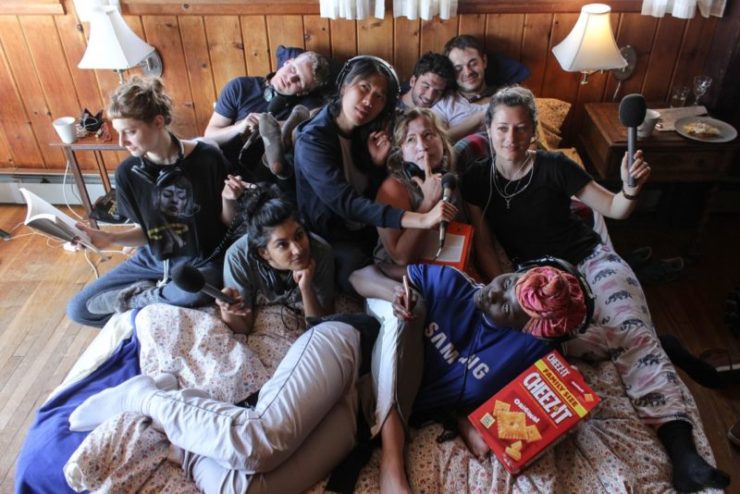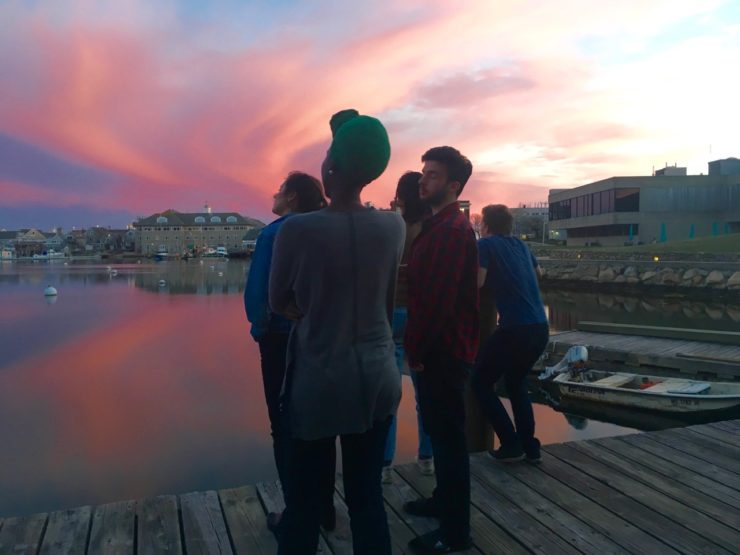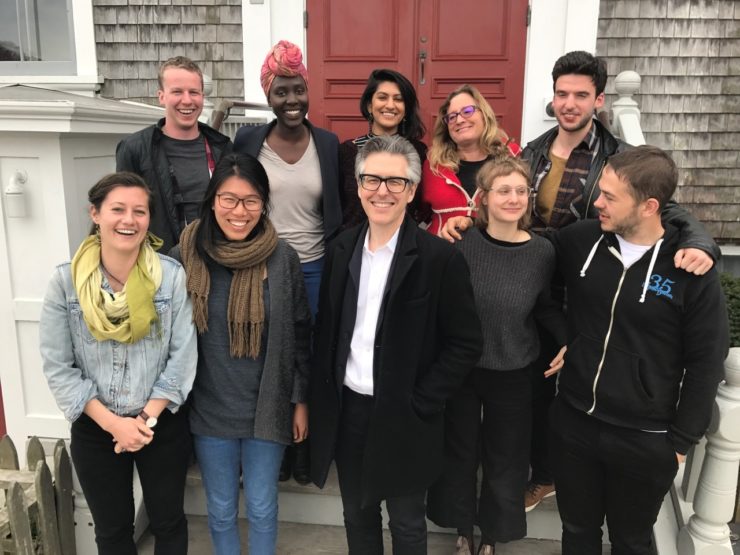
"We were nine students, all younger than 30 – except me."
Nearly two years ago, I was one of dozens of Los Angeles Times reporters who took a buyout and left the paper. I liked my job almost all the time. Sometimes I loved it. But I’d done it for 23 years. I was ready to grow.
We lived together and learned from one another. And we each worked hard to push past our anxieties and master the sorcery of the “magic stick.”
For decades, I’d made visual art on the side — some sculpting, some painting. I’d written poetry — mostly in secret, with a coven of non-journalists. I wanted to meld my disparate selves in the service of a new kind of storytelling.
In my reporting career, which has gravitated toward people who aren’t often heard, I’ve tried to get out of my own way in my writing to let my subjects speak. Audio, with its raw intimacy, seemed a perfect next step. Shaping the textures of voice, sound and music also seemed like a kind of sculpting. I was sold.
So I was thrilled when I was admitted to The Transom Story Workshop, a nine-week intensive training program in Woods Hole, Mass., for budding audio storytellers.
In the off season, the coastal Cape Cod village is an odd blend of Gore-Tex-clad oceanographic researchers and old-timers with tales of barroom brawls from commercial fishing days. And then there was us.
We were nine students, all younger than 30 – except me. We lived together and learned from one another. And we each worked hard to push past our anxieties and master the sorcery of the “magic stick.” That’s Transom lead instructor Rob Rosenthal’s moniker for the microphone, which, wielded gently, taps the personal truths of strangers. I always knew that people wanted to tell their stories. In radio, those stories feel wild caught.
Transom launched me into the world as a baby radio producer. And I’m pretty sure it will make me a stronger narrative print writer.

Sunset on Cape Cod during the nine-week Transom program.
There may not be many midcareer print journalists who are eager to take this kind of a leap. But there are plenty of journalists — particularly freelancers — who want to broaden their reach by moving beyond the confines of print into podcasting or radio.
But writing for print doesn’t translate to radio. In fact, it breeds habits that Rob cheerfully promised to beat out of me.
Rob’s the mastermind behind Transom’s “HowSound,” a podcast about radio storytelling. In one episode, “How Not to Write for Radio,” Rob kindly self-immolates for the greater good, deconstructing one of his own early radio pieces. A few of his top takeaways: Write like you talk, and “pretend you’re being paid by the period.” In other words, keep your sentences short. As a longtime print dash-a-holic, this was hard for me. But in radio, listeners can’t glance back to review what you’ve previously told them.
Read this New York Times lede from 1990 and imagine hearing it on the radio:
“Gene therapy for human disease took a leap from the theoretical realms of the laboratory toward the real world of practical medicine today as a National Institutes of Health panel approved a proposal to treat children with a severe genetic disease by inserting new genes into their blood cells.”
Nobody speaks that way. But beyond that, the sentence contains too much complexity. In radio, you’ve got to spoon-feed your listeners. One idea at a time. Write in the present tense. Pick active verbs. And sentence fragments? They’re your friends. In moderation.
In my reporting career, which has gravitated toward people who aren’t often heard, I’ve tried to get out of my own way in my writing to let my subjects speak. Audio, with its raw intimacy, seemed a perfect next step.
Nancy Updike, one of the founding producers of “This American Life” and a terrific writer, shared her wisdom with Transom back in 2006. One of her favorite openers comes from a 2005 NPR piece by David Kestenbaum:
On a nondescript patch of desert in Utah live two neighbors who no longer talk to each other. Nuclear waste is the source of their disagreement. Leon Bear and Margene Bullcreek, with about a dozen others, live on the Goshute Native American reservation in Skull Valley. Leon Bear wants to rent out the reservation to store much of the nation’s spent nuclear fuel. Bullcreek, who lives across the street from Bear, hates the idea.
Only two of these sentences contain clauses, and they’re brief. With only one descriptor, “nondescript,” the listener feels the isolation. The writing telegraphs a doozy of a conflict between neighbors, with really high stakes. It’s frill-free. But it’s evocative.
The rules of story structure differ from print, too. Building thematic sections or jumping around in time is just not possible in radio. You’d lose your listener. Chronology rules, even if interrupted by a side journey. That doesn’t mean you can’t start a piece in the middle (or end) of a tale — before looping back to the beginning and following the clock: This happened, then this happened, then this happened.
Yet another difference that took some adjusting: In print, quotes are often set up with an explanation or summary of what’s to come. Radio is more like a relay race. The tape, or quotes, pick up where narration leaves off. You’re always moving the story forward. As for fact-y bits, they’re best told in narration. Raw emotion? That’s where the tape comes in.
All of this was easier said than done.
For my final project at Transom, I reported and produced a piece about a woman named Jennie who functioned well for years, raising a daughter, designing a home, pouring her energies into her job as director of a Cape Cod village library. Then her past overwhelmed her present. She had suffered years of childhood sexual abuse, and her coping mechanisms just gave out. It got so bad that she wanted to be dead. Then she went to a trauma treatment program. She was diagnosed with PTSD, and learned how it physically changes the brain. Once she came home, she set to work trying to reverse some of those changes so she could live a full and honest life.

The group with Ira Glass after he spent time with the students as a visiting instructor.
I decided to start in the present, to bring readers into Jennie’s world of healing, and then loop back to the chronology. But my print habits overloaded the opening narration. I wanted listeners to understand how Jennie’s brain had changed, why it matters, what she wants for her future. This is from my first draft:
Jenny Wiley’s brain thinks yesterday is now. Terror from her past overwhelms her present. Old habits – checking out, living in a fog – kick into high gear at the smallest provocation. But this isn’t about what happened to Jennie or who did it. It’s about who she is today and who she’s working really hard to become. A woman who can be fully present in her life. Show up for those she loves. Make good memories and hold on to them. And actually get some rest when she goes to sleep. But it’s tough. May 1 was not a good day.
For print, that might have worked. For radio, it was way too long. It introduced too many ideas. For my final script, I whittled it down to this:
Jennie Wiley wants nothing more than to be fully present. To be in the ‘here and now.’ Sometimes, that’s nearly impossible. Take May 1.
I ran into another radio-centric problem. Jennie was eloquent about her PTSD in our interviews. But she was telling and not showing. When she talked about horrific nightmares, I could imagine what she experienced, but I couldn’t feel it. Because she wasn’t feeling it. She was telling it. For print, I could have used that detail to craft scenes that conveyed the immediacy of her emotion. In radio, that wasn’t going to work. Listeners would need to experience what Jennie feels just about every day, so they could feel it too. I asked her to record voice memos when she was alone, in the heat of her symptoms, and as she worked to wrench herself back into the present. They saved the piece.
Jennie also allowed me to come to therapy with her, an act of courage and trust that allowed me to create another powerful scene. I was crouched on the floor with my microphone. It was awkward at first. But then Jennie and the therapist got to work and forgot about me.
And I came away with a piece that allowed me to get out of the way so Jennie could tell her story, in her own voice. Take a listen.


